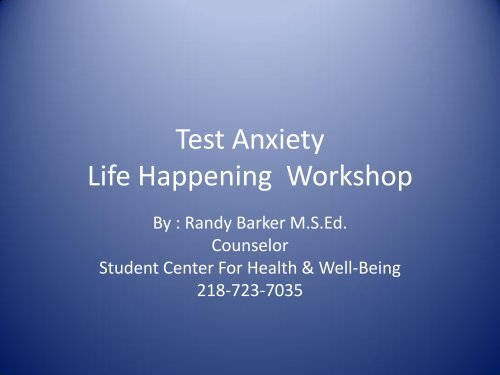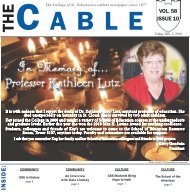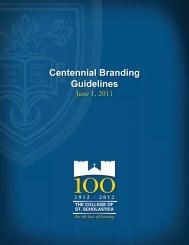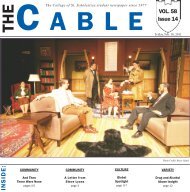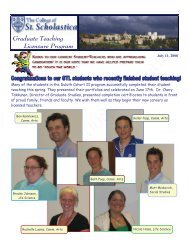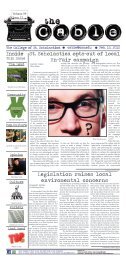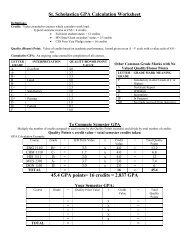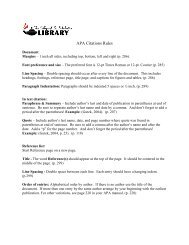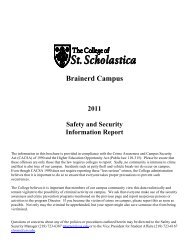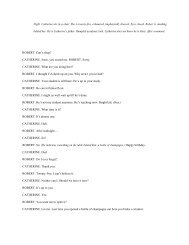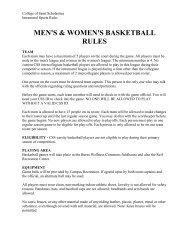Test Anxiety Life Happening Workshop
Test Anxiety Life Happening Workshop
Test Anxiety Life Happening Workshop
You also want an ePaper? Increase the reach of your titles
YUMPU automatically turns print PDFs into web optimized ePapers that Google loves.
<strong>Test</strong> <strong>Anxiety</strong><br />
<strong>Life</strong> <strong>Happening</strong> <strong>Workshop</strong><br />
By : Randy Barker M.S.Ed.<br />
Counselor<br />
Student Center For Health & Well-Being<br />
218-723-7035
Normalization:<br />
Most students experience some level of<br />
anxiety during a exam.
Research Has Shown:<br />
• A certain amount of anxiety and worry can be<br />
beneficial. In research comparing test scores<br />
of students who enter exams either<br />
completely relaxed, somewhat anxious or very<br />
anxious, the students who were somewhat<br />
anxious preformed the best.
Problem:<br />
• When test anxiety starts to affect exam<br />
performance negatively it has become a<br />
problem.
What is <strong>Test</strong> <strong>Anxiety</strong>?<br />
• A reaction to anticipating something stressful<br />
• The nervous feeling some get before they take<br />
an exam<br />
• <strong>Test</strong> anxiety has a direct correlation to how<br />
prepared one is for an exam<br />
• It is not genetic<br />
• It is something you’ve learned to do and CAN<br />
be unlearned
Characteristics of <strong>Test</strong> <strong>Anxiety</strong><br />
• Headaches<br />
• Nausea<br />
• Body temperature<br />
changes<br />
• Excessive sweating<br />
Physically:<br />
• Shortness of breath<br />
• Light-headedness<br />
• Rapid heart beat<br />
• Dry mouth
Symptoms of <strong>Test</strong> <strong>Anxiety</strong> Emotionally<br />
• Excessive feelings of<br />
fear<br />
• Disappointment<br />
• Anger<br />
• Depression<br />
• Uncontrollable crying or<br />
laughing.<br />
• Feelings of helplessness
Symptoms of <strong>Test</strong> <strong>Anxiety</strong> Behaviorally<br />
• Fidgeting<br />
• Pacing<br />
• Substance abuse<br />
• Avoidance
Symptoms of <strong>Test</strong> <strong>Anxiety</strong> Cognitively<br />
• Racing thoughts<br />
• Going Blank<br />
• Difficulty concentrating<br />
• Negative Self-Talk<br />
• Feeling of dread<br />
• Comparing yourself to<br />
others<br />
• Difficulty organizing<br />
your thoughts
Where does it come from?<br />
• Lack of preparation/lack of good study skills<br />
• Inadequate information<br />
• Difficulty with time management and<br />
internal/external pressures<br />
• Fear of being evaluated<br />
• Fear of failure<br />
• Perfectionism<br />
• Competition<br />
• Catastrophic thinking
Why The Body Reacts<br />
• It receives a stimulus<br />
• It interprets the meaning of that stimulus.<br />
• It selects a response<br />
• It enlists the body to cooperate as needed.
“If I continue to do what I’ve done, then I<br />
going to get what I’ve always got. “
Exercise #1 Don’t Think About a Pink<br />
Elephant<br />
• This exercise is designed to help see what<br />
trying to suppress and control unwanted<br />
thoughts get you.
Exercise #2<br />
Chinese Finger Trap
Here’s The Good News:<br />
• You can choose a new approach to get a<br />
different result. The goal of this workshop<br />
tonight is to give you several new ways of<br />
doing things to get different results.
“The truth is that our finest moments are most<br />
likely to occur when we are feeling deeply<br />
uncomfortable, unhappy, or unfilled. For it is<br />
only such moments, propelled by our<br />
discomfort, that we are likely to step out of<br />
our ruts and start searching for different ways<br />
or truer answers.” -M. Scott Peck
Research Has Shown:<br />
• that the solution to worry, anxiety and fear is<br />
not more struggle: The solution to your test<br />
anxiety is not to fight “better or harder.”
Findings:<br />
• The solution is to change your relationship<br />
with, and your response to your anxious<br />
thoughts and feelings.<br />
• To get there, you’ll need to learn how to<br />
acknowledge thought and feelings without<br />
“becoming” them and without acting on them<br />
and doing what they say
Exercise #3<br />
Mind Watching
Mind Trap<br />
• When you go beyond seeing words as words<br />
images as images you’re buying into the<br />
illusions your create. The thoughts and<br />
images shift from being thoughts and images<br />
to be something bad such as failing the test,<br />
failing the class. And when that happens you<br />
often find yourself trapped in old behaviors<br />
patterns that are neither helpful nor in your<br />
best interest “ We call this the mind trap.”
Here’s The Key Point:<br />
• Much of your ability to control is based on this<br />
principle: <strong>Test</strong>, exams are anxiety driven only<br />
after we apply meaning to them e.g., A store<br />
is just a store, A speech is just a speech and a<br />
test is just a test.<br />
• When you fuse with your thoughts you tend<br />
to treat them “as if” they were the same<br />
things as the experience or events they<br />
describe.
• F-alse<br />
• E-vidence<br />
• A-pperaing<br />
• R-eal<br />
What is Fear?
Ending Your Struggle with <strong>Anxiety</strong> Is<br />
The Solution<br />
• The good news is that there’s another way: you could give<br />
up the struggle with anxiety-and you could surrender.<br />
• I can drop the rope and end the fight with myself.<br />
• It means allowing yourself to feel anxiety just as it is, just as<br />
it comes, instead of trying not to feel anxiety.<br />
• You can learn to have those unpleasant thoughts and<br />
feelings and learn how to distance yourself enough to do<br />
well on test , exam.
Feeding a Painful Wolf or a<br />
Compassionate Heart<br />
A Native American grandfather was talking to his<br />
grandson about how he felt. He said, “ I feel<br />
as if I have two wolves fighting in my heart.<br />
One wolf is the vengeful, angry, violent one.<br />
The other wolf is the loving ,compassionate<br />
one. “The grandson asked him, “Which wolf<br />
will win the fight in your heart? The<br />
grandfather answered, “The one I feed.”
Story:<br />
The Struggle of the Two Mice
You Control Your Choices, Actions, &<br />
Destiny<br />
• We can conclude that we cannot choose<br />
whether or not we feel anxiety, yet we can<br />
decide what we do with those feelings and<br />
thoughts when they show up.<br />
• In short you’re free to choose how you<br />
respond and what you do.<br />
• Learning to respond differently than you’ve<br />
done in the past is the key to getting unstuck.
What Acceptance Is & Can Do For You<br />
• Acceptance means “to take what is offered.”<br />
• Acceptance is about acknowledging and<br />
experiencing what happened in the past and<br />
what’s happening in the present moment<br />
without getting all tangled up in that experience.<br />
• Anything that is fully experienced will disappear.<br />
As soon as you begin to express an emotion, you<br />
begin to change it.<br />
• Remember, softness will wear away rock-the<br />
hardness that underlies your tendency to struggle<br />
and to fight.
What Acceptance Is & Can Do For You<br />
• Whenever you are highly tense and anxious<br />
you ability to think logically is greatly<br />
diminished. Once you stop the fight with<br />
yourself you have more room to concentrate<br />
on the situation at hand. Any relaxation<br />
technique would increase your ability to think<br />
clearly, and therefore increase self control.
Learning Mindful Acceptance:<br />
• Breathing is our most powerful tool. Our<br />
breathing patterns are always involved in<br />
anxiety, they are either part of the solution of<br />
the problem.
Breathing:<br />
• Once you can control your breathing patterns<br />
you are on the road to success. For some<br />
people indentifying and mastering breathing<br />
patterns will completely end their symptoms<br />
and resolve their problem.
Breathing<br />
• It appears that people under stress not only<br />
begin to increase their respiration rate, but<br />
they also shift from breathing into lower parts<br />
of their lungs to breathing into upper parts.
Breathing<br />
• The habit of slow easy diaphragmatic<br />
breathing invites the “Calming Response”<br />
promoting good health, and providing long<br />
term effects.<br />
• By changing your breathing patterns you can<br />
increase your fight against test anxiety. By<br />
changing your breathing pattern during an<br />
test, or exam you can reverse your body’s<br />
anxiety provoking symptoms.
Two Important Things:<br />
1. Learn to breath from your diaphragm and<br />
make breathing patterns part of your daily<br />
life.<br />
2. Become skilled at shifting to this kind of<br />
breathing whenever you begin to feel<br />
anxious.
Another Important Note:<br />
• Learning skills of meditation can dramatically<br />
increase you ability to control your fearful<br />
thinking by teaching you new ways to respond to<br />
your atomic, thoughts, emotions and images.<br />
• It allows you to step away from these experiences<br />
to become a detached, quite observer of your<br />
thoughts, emotions, and images, as though you<br />
were watching them from the outside.


